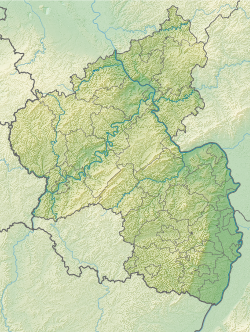Hunnenstein (Schmidthachenbach)
| Hunnenstein (Schmidthachenbach) Heldenstein , Hellenstein or Hollenstein | ||
|---|---|---|
|
|
||
| Coordinates | 49 ° 43 '20.7 " N , 7 ° 26' 55.7" E | |
| place | Schmidthachenbach , Birkenfeld district , Rhineland-Palatinate , Germany | |
The Hunnenstein (historically also known as Heldenstein , Hellenstein or Hollenstein ) is a menhir near Schmidthachenbach in the Birkenfeld district in Rhineland-Palatinate .
Location and description
The menhir is located southwest of Schmidthachenbach and southeast of Mittelreidenbach on the Winneberg, just below the highest point.
The menhir is made of melaphyr . It has a height of 177 cm, a width of 60 cm and a depth of 27 cm. It is plate-shaped, slightly curved, tapers upwards and ends in a flat point. A smaller stone is leaning against the Hunnenstein, which is probably a broken piece. There were several burial mounds in the vicinity. The Hunnenstein could originally have served as a grave stele and would have been erected by the Hallstatt period at the latest .
The menhir in regional sagas
There are two legends about the Hunnenstein . According to the first, a troop of Huns are said to have camped here during their raids in the 5th century. After they sacked the whole area, an argument broke out over the unjust division of the booty and the leader of the Huns was slain. Then he was buried with all his treasures and a large stone was erected on the grave, which from then on bore the name Hunnenstein.
A second legend tells of the knight Udo von Hachenfels. During a hunt, he stopped and fell asleep under a tree. Frau Holle appeared to him in a dream . She wanted him to have the honor of seeing her in person. But he would have to erect a memorial stone for her. When the knight woke up again, he actually saw an old woman running quickly down into the valley. He kept his obligation, had a large stone blasted off the Hachenfelsen and set it up where he had his dream. The stone was named Hollenstein after Mrs. Holle.
literature
- Gustav Behrens: Birkenfeld soil finds. In: Trier magazine. Volume 19, supplement, 1950, p. 45.
- Otto Gödel: Menhirs, witnesses of cult, border and legal customs in the Palatinate, Rheinhessen and the Saar area. Speyer 1987, p. 115ff.
- Johannes Groht : Menhirs in Germany. State Office for Monument Preservation and Archeology Saxony-Anhalt, Halle (Saale) 2013, ISBN 978-3-943904-18-5 , pp. 270, 344–345.
- Horst Kirchner: The menhirs in Central Europe and the menhir thought. Academy of Sciences and Literature, Treatises of the Humanities and Social Sciences Class, born in 1955, No. 9, Wiesbaden 1955, p. 157.
